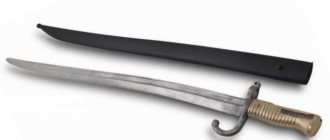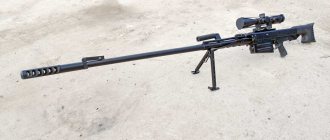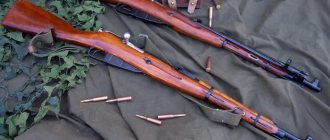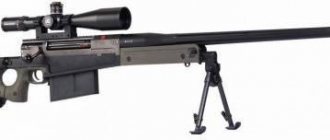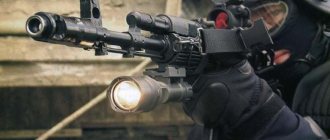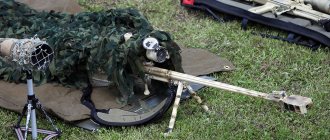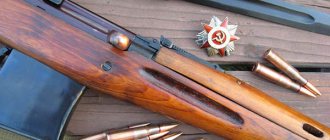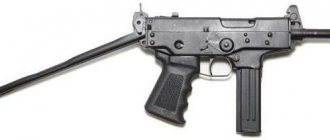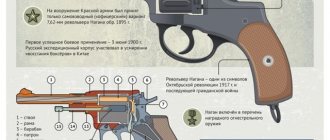Before Colonel Lebel's model, the French troops were armed with single-shot Gra rifles of the 1874 model, "partially magazine" Austrian Kropachek and Italian Vetterli, all 11 mm caliber chambered for black powder. Please remember the second part of this sentence especially. The Gra rifle was single-shot, like the Russian Berdanka; the Kropachek rifle had an under-barrel magazine with 7 rounds. The mechanism of the Gra-Kropachek rifle model 1884 with the original sliding bolt and under-barrel magazine was advanced, reliable and “comprehensively tested” for its time. They even said that the Gra-Kropachek rifle was designed more successfully in comparison with the German Mauser rifle of that time. In principle, the Gra rifles satisfied the military in everything except... black powder in the cartridge.
And that's why.
We all watched films about the war. The old war, where they still shot from flintlock rifles, which were loaded from the muzzle. So, when firing from such a gun, a cloud of dense powder smoke appears in front of the shooter, which does not dissipate for a long time in calm weather. When the shooter loaded the gun from the muzzle, the smoke had time to dissipate. But when breech-loading guns were introduced, the rate of fire increased sharply. But due to the dense powder smoke, the shooter fired the second shot through the smoke, and the third shot almost blindly. And when the rifle became multi-charged, the problem of increasing the rate of fire of small arms became insoluble; there was no point in increasing the rate of fire if the shooter did not see where to shoot.
And one more disadvantage of black powder. In the 60s of the 19th century, there were already rifles from which an experienced shooter could hit a target at a distance of more than 500 m, but black powder detected the shooter from the first shot, so it was almost impossible to carry out long-term hidden shooting from weapons with black powder.
The French were not the first to recognize this problem, but they were the first in the world to solve it. And how they decided!
It was they who made the world's first cartridge with smokeless powder, which later became known as the “8×50R Lebel”. The inventors of gunpowder are the chemist Paul Viel and the army captain Desalo. The cartridge itself was developed by Lieutenant Colonel Nikolaus Lebel, head of the army shooting school. This was the first cartridge with a bullet coated with a dense alloy.
The thing is that soft lead, when twisted in a long barrel, is unpredictably “ripped off” and at the same time, firstly, it slows down greatly, and secondly, the trajectory of the bullet becomes less predictable. In order to avoid these “unpleasant” effects, the bullet, for example, for the Russian “Berdanka”, was wrapped in salted paper. It was very low-tech in production, plus the rifling of the barrel bore quickly clogged, which required frequent cleaning of the weapon. In addition, the jacketed bullet also had increased penetration properties, because the metal of the jacket was stronger than lead.
To increase the speed of the bullet, the cartridge was made in a bottle shape, with a larger cylinder for gunpowder and a smaller cylinder for the bullet. To make the trajectory more flat, the caliber was reduced from 11 to 8 mm, which, by the way, made it possible to greatly reduce the weight of the weapon.
A large group of specialists took part in the creation of a rifle chambered for the new cartridge: military specialists Lebel and Bonz, technician Claus, engineer Viel. Although the weapon was developed very quickly, the rifle was constructed, according to the selection committee, “quite satisfactorily.”
The bolt mechanism of the new rifle was left the same, the magazine was left to the Kropachek design, under the barrel, there is nothing to change what was tested in battles for who knows what. The stock consists of two parts: a butt and a forearm with a drilled magazine, these parts were cut separately from walnut wood and fastened with iron plates, so it was easier for production and repair. A cleaning rod is not provided; it is replaced by a rope wipe. The rifle was sighted without a bayonet, which significantly increased shooting accuracy. The front sight is triangular in shape with a thin cutout in the middle - for particularly accurate shooting. For the first time, a sector sight was used, as on modern Kalashnikov assault rifles, marked for shooting up to 2400 m. This is about five times further than the old Gra rifle!
In 1886 it was adopted by the French army. For outstanding services, Nikolaus Lebel was awarded the rank of colonel and appointed commander of an infantry regiment, and the rifle created under his leadership was called the Lebel system rifle.
The rifle’s first baptism of fire took place not in Europe, but in the jungles of distant Madagascar. The French, using new rifles, shot at the natives at a distance of about 2 km, not giving the enemy the opportunity to come within rifle range. In 1893, the receiver was strengthened and a hole was drilled in the bolt head to vent gases (to reduce the risk of injury to the shooter if the bolt ruptured), but overall the design was left the same.
Lebel rifle - video
In 1898, it also became the first rifle in the world to receive a cartridge with an ogival-shaped bullet (with a pointed nose and a beveled rear). After making some changes to the design in 1893 it received the name Fusil Mle 1886 M93. Despite a number of shortcomings, it remained the standard weapon of the French infantry until the second half of the 1930s.
Creation and production
In 1884, the French chemist Paul Viel created smokeless gunpowder, which he called Poudre B. This substance turned out to be three times more powerful than black gunpowder of the same weight, and when it burned, there was practically no smoke left. Around the same time, rifle cartridges with full metal jacket bullets appeared: their lead core was completely covered with a copper alloy. This invention is usually attributed to the Swiss officer Edouard Ruben. This design prevents the bullet from melting in the barrel and leaving lead particles on the rifling, so you can increase the initial velocity and make the rifling steeper to increase the stability of the bullet in flight.
The French Minister of War, General Boulanger, demanded that these two inventions be immediately combined in the design of a new rifle. He appointed General Tramont (French) as chairman of the commission and gave him a term of one year. At that time, the French army was armed with the Gra breech-loading rifle, and the navy had a Kropacek rifle with an under-barrel magazine. Both are chambered for the 11mm Gra cartridge with black powder.
Boulanger's idea was to transfer the army directly from single-shot rifles chambered for black powder to magazine-fed rifles chambered for smokeless powder, avoiding the "intermediate" options (magazine rifles chambered for black powder). First of all, since the new powerful gunpowder made it possible to move to a smaller caliber to improve ballistics, Colonel Basil Gras (along with Lieutenant Colonel Etienne Desaleux) “squeezed” the 11-mm cartridge case for an 8 mm bullet. The idea of an under-barrel magazine was taken almost unchanged from the Gra-Kropachek rifle mod. 1884. Its reloading mechanism for the new weapon was modified by Albert Close and Louis Verdun at the Chatellerault Arsenal.
Rifle bolt
Colonel Bonnet, inspired by the Swiss design of Vetterli, created a bolt with two radial lugs located in front of the combat cylinder. The head of the commission, General Boulanger, proposed the idea of a bullet with a flat nose - this was a fairly common solution for weapons with a tubular magazine: since in such a magazine the cartridges are located one after another, with the bullet towards the bottom of the next cartridge case, there was a danger that the bullet could pierce the primer during a shock or impact next cartridge. The practical implementation of the idea, called Balle M (“Bullet M”), was carried out by Lieutenant Colonel Nicolas Lebel, head of the Army Shooting School.
The bullet he created was named after Lebel, then it was transferred to the entire cartridge (and 8-mm caliber), and within the framework of the commission - despite the “friendly protests” of Lebel himself - the entire design began to be named after him. Lebel, as the head of the shooting school, supervised the army tests of the rifle, after which the name became widespread (but still unofficial). He himself stated that the greatest contribution to the creation of the rifle was made by the experienced designer Colonel Gra.
In 1887, minor changes were made to the fastening of the firing pin, and in 1893, the shape of the firing cylinder was changed so that if the cartridge case ruptured in the chamber, hot gases would not get into the shooter’s face. At the same time, the sight mount was strengthened, a hook was introduced for placement in the pyramid, and the safety was finally abandoned. The modified rifle was designated Fusil Mle 1886 Modifié 93.
In 1898, Colonel Desaleux introduced a new bullet - pointed and with a beveled rear, which dramatically improved its ballistics. The Balle D was the world's first ogival bullet. It was adopted for service in 1901. Since then, there have been virtually no parts left in the “Lebel rifle” that were actually created by Lebel.
Bayonet of the French Lebel rifle model 1886
The new bullet weighed 12.8 g and allowed (in theory) to fire at almost 4 kilometers. The maximum effective firing range was determined to be 1800 m. More importantly, the direct shot range increased to approximately 420 m. The new bullet trajectory required modifications to the sighting devices.
To prevent a bullet in the under-barrel magazine from piercing the capsule of the next cartridge with its sharp nose, the capsule was made with a rather thick wall and a convex shape, and an annular recess was made in the bottom of the cartridge case, where the bullet nose would slide off the convex capsule.
Production took place at three state-owned arms factories - in Chatellerault, Saint-Etienne and Thule. The arsenal at Chatellerault alone produced an average of 900 guns per day. France completed the program of completely re-equipping the army with new rifles in 1889; production finally ceased in 1920.
For rifles that survived the First World War, worn barrels were replaced with new ones until 1930.
Design
The weapon is a repeating rifle with an integral under-barrel tubular magazine for 8 rounds fed by a spring. The sliding bolt is locked due to two lugs in the front part of the combat cylinder. In the closed position, the stem of the bolt handle almost rests against the rear wall of the receiver cutout, which was considered an additional safety measure when using new powerful cartridges.
The barrel is 800 mm long with four left-hand rifling. The next cartridge is fed into the chamber manually using a bolt that drives the swinging feeder tray. The magazine is loaded manually, one at a time, through the receiver window. The total capacity of the rifle can be increased to ten rounds: in addition to eight in the magazine, one more can be manually placed on the feeder tray and one more can be placed in the chamber.
The safety device in the first model was represented by a rotating trigger (a similar system was used in the Mosin rifle). In the 1893 model, the safety was abandoned altogether, since on the march the rifle was still carried with a loaded magazine, but an empty chamber.
A magazine cut-off is installed on the right side of the receiver. In the “on” position, it prevents the supply of cartridges from the magazine, turning the rifle into a single-shot rifle. It was assumed that the shooter should save the cartridges in the magazine for the critical moment of the battle, and before that load the weapon “the old-fashioned way” manually. Many rifles of that time were equipped with such devices. However, determining the onset of a “critical moment” is very difficult, and therefore cutoffs quickly fell out of use.
Rifle Lebel Mle. 1886, left view
Rifle Lebel Mle. 1886, right view
The tubular under-barrel magazine turned out to be the focus of both the advantages and disadvantages of the rifle: on the one hand, this design made it possible to create a compact rifle with a large amount of ammunition - almost twice as much as most models of its time; on the other hand, the magazine had to be loaded manually, one cartridge at a time, and as a result, the practical rate of fire of the Lebel was inferior to rifles with clip-on and, especially, burst loading.
The rifle stock is wooden, made of two parts. Despite its unprepossessing appearance, the rifle turned out to be well balanced and provided quick and comfortable fitting.
The weapon is equipped with a needle tetrahedral bayonet (Épée-Baïonnette Modèle 1886) 52 cm (20 inches) long. The shape of the bayonet makes it easy to pierce leather items of equipment and thick, dense fabric. During World War I, French soldiers called this bayonet by the feminine name "Rosalie". Soldiers often shortened such bayonets to create a trench stiletto knife. The bayonet was attached quite rigidly: the protrusion under the barrel fit into the groove of the handle, and the guard ring was put on the barrel, while the cutout of the ring was fixed on the wide front sight. The latch button was located on the bayonet on the left side under the guard. During the war, simplified versions of bayonets were produced - with brass handles (instead of the standard nickel silver) and a modified guard shape. In 1916, a bladed bayonet was developed, double-edged and slightly curved, almost half the length of the standard one. However, it was never accepted into service.
The sighting devices consisted of an open front sight and a stepped sight, marked up to 2000 m. With the adoption of the pointed “D” bullet, new sights were installed, up to 2400 m. If you fold the sight frame forward, a fixed sight opens at 400 m (which was used most often ). Sniper rifles were equipped with APX optical sights mod. 1916 and 1917 with three times magnification.
French troops 1914, Battle of the Marne, armed with a Lebel Mle 1886 rifle
Service history
The appearance of the Lebel rifle forced other countries to develop their own repeating rifles chambered for a small-caliber (by the standards of that time) cartridge with smokeless powder. In Germany and Austria-Hungary, such models were adopted into service in 1888, in Italy and Russia - in 1891, and in Great Britain - in 1895.
During the First World War, the rifle established itself as a very accurate, powerful and reliable weapon, capable of withstanding the conditions of trench warfare. Despite all the shortcomings of the Lebel, the French infantry clearly preferred it to the Berthier rifle, primarily because of the more capacious magazine. During the war, the VB (Viven-Bessieres) muzzle grenade launcher mod. 1916, fired using a blank cartridge.
After the Lebels were armed with the infantry of the Metropolis, the Berthiers were sent to the colonial troops and the Foreign Legion. However, based on the experience of the war, the legionnaires demanded that they be re-equipped with the Lebel, which was mainly accomplished in the 1920s (however, rifles remained in service with some units of the Foreign Legion even after the end of World War II).
Surplus rifles remaining after demobilization were sold abroad - to Poland, Greece, Turkey, and Bulgaria.
After the end of the war, the need to modernize the cartridge and rifle was obvious; however, the difficult - economically and politically - post-war period in France did not allow these plans to be fully realized. A sample of the new MAS-36 rifle was ready already in 1929, but only in 1936 it was officially accepted into service and before the start of the war they did not have time to re-equip all the units, so the second-line troops faced the war with the Lebels.
After the start of the Great Patriotic War, along with other foreign-made weapons, Lebel rifles entered service with some units of the people's militia (thus, 168 pieces of Lebel rifles were transferred to the arsenal of the people's militia battalion of the Kuibyshevsky district of Moscow, along with other weapons from the warehouses of the Moscow Military District, at the end In 1941, Lebel rifles were issued to the Tula Workers' Regiment, with only 5 rounds of ammunition per rifle).
Options and modifications
- in the 20s, new rifle ammunition was developed to replace the outdated Lebel cartridge, of which 7.5x54 mm was ultimately chosen. A number of Lebel rifles were converted to it in 1927; the key change was a new in-line magazine with 5 rounds. The carbine was designated Mle 1886-93-27 . However, with the development of a fundamentally new MAS-36 rifle chambered for this cartridge, the need to convert Lebels for it disappeared;
Carbine Lebel Mle 1886-93-27, right view
Carbine Lebel Mle 1886-93-27, left view
- in 1935, in Tulle they began converting rifles into Mousqueton Mle 1886 M93-R35 . They used the same Lebel cartridge and were completely identical to the rifle, with the exception of a barrel shortened to 450 mm and, accordingly, a shortened under-barrel magazine, which now held only three cartridges. The carbines were intended for cavalry units in North Africa. Until 1940, about 50 thousand barrels were converted. The weapon was criticized by the military for its extremely strong recoil.
Lebel carbine Mle 1886 M.93 R.35, left view
Lebel carbine Mle 1886 M.93 R.35, right view
Berthier rifles and carbines caliber 8 mm. Device
Since it was difficult to win the war with single-shot rifles, it was decided to release a rifle of the Berthier Mle 1907 system, to which a standard Lebel rifle bayonet could be attached. In addition, the stem of the bolt handle was made straight rather than curved, and became thicker. The frame-step sight was marked up to 2400 meters. Under the name Fusil d'Infanterie Mle 1907/15, thousands of these rifles were manufactured and issued to the troops during the First World War.
Photo of the Lebel rifle
French soldiers with a Lebel Mle 1886 M.93 rifle
Russian soldiers in France armed with Lebel rifles
Similar
AK-47 assault rifle cartridge caliber 7.62 mm.
Device. Rate of fire AK-74 assault rifle cartridge 5.45 mm caliber. Device. Rate of fire
Dragunov SVD sniper rifle caliber 7.62 mm. Device
AKS-74U assault rifle cartridge caliber 5.45 mm. Device. Weight
Mauser K96 pistol cartridge caliber 7.63 and 9 mm. Device
Pistol Walter PP / PPK cartridge caliber 7.65 and 9 mm. Device
Pistol Yarygin PYa Grach cartridge caliber 9 mm. Device
DShK machine gun cartridge caliber 12.7 mm. Device. Rate of fire
Luger pistol R.08 Parabellum cartridge caliber 9 mm. Device
Pistol PM cartridge caliber 9 mm. Rate of fire. Dimensions. Bullet speed. Sighting range
Self-loading shotgun Saiga-12 cartridge, caliber. Device
Maxim machine gun cartridge caliber 7.62 mm. Device. Weight
PPSh-41 Shpagina submachine gun cartridge caliber 7.62 mm
APS Stechkin pistol cartridge caliber 9 mm. Device
Nagan system revolver cartridge caliber 7.62 mm. Device
Kalashnikov PK machine gun and PKM cartridge caliber 7.62 mm. Device
Simonov carbine SKS-45 cartridge caliber 7.62 mm. Device
Rifles and carbines Mauser 98 caliber 7.92 mm. Device
PPS-42 and PPS-43 Sudaev submachine gun cartridge caliber 7.62 mm
Pistol Walter P38 cartridge caliber 9 mm. Device
MP-40 German submachine gun cartridge caliber 9 mm. Device
VSS Vintorez sniper rifle caliber 9 mm. Device
Submachine gun PP-91 Kedr cartridge 9 mm caliber. Device
Light machine gun RPK-74 cartridge caliber 5.45 mm. Device
Pistol Glock 17 cartridge caliber 9 mm. Device
Makarych, Izh-79-9T, MR-79-9TM, MP-80-13T traumatic pistol
AK-12 assault rifle cartridge caliber 5.45 mm. Device. Weight
Mosin rifles and carbines Three-line caliber 7.62 mm
PMM Makarov pistol modernized 12 rounds. Device
Revolver Colt Single Action Army (SAA) Peacemaker. Device
Machine gun PKP Pecheneg cartridge caliber 7.62 mm. Device
Sniper rifle VSSK Exhaust caliber 12.7 mm. Device
Beretta pistol 92 cartridge caliber 9 mm. Device
TT - Tokarev pistol cartridge caliber 7.62 mm. Device
Submachine gun PP-19 Bison cartridge caliber 9 and 7.62 mm. Device
Sniper rifle SV-98 caliber 7.62 mm. Device
Vladimirov KPV machine gun cartridge caliber 14.5 mm. Device
ASH-12 assault rifle cartridge caliber 12.7 mm. Device. Rate of fire
PSM pistol cartridge caliber 5.45 mm. Device
Pistol Colt M1911A1 cartridge caliber 45. Device
Smith-Wesson revolver Russian cartridge, caliber 10.67 mm. Device
Degtyarev DP-27 light machine gun, 7.62 mm caliber cartridge. Device
Shotgun Mossberg 500 Cartridge. Dimensions. Rate of fire. Sighting range
Thompson submachine gun cartridge caliber 11.43 mm. Device
Pistol USP Heckler und Koch cartridge, caliber. Device
Hunting carbine OSK-88 (SVT-40) caliber 7.62 mm. Device
AS Val silent automatic cartridge caliber 9 mm. Device
Submachine gun PP-19-01 Vityaz cartridge 9 mm caliber. Device
Machine gun Kord cartridge caliber 12.7 mm. Device. Weight. Sighting range
Osa - traumatic pistol cartridge, caliber. Device
AK-9 assault rifle cartridge caliber 9 mm. Device. Rate of fire
Degtyarev RPD light machine gun, 7.62 mm caliber cartridge. Device
Automatic OTs-14 Groza cartridge caliber 9 mm and 7.62 mm. Device
Czech pistol CZ-75 (modifications). Device
Browning pistol 1903 cartridge caliber 9 mm. Device
Sniper rifle OSV-96 caliber 12.7 mm. Device
FN P90 submachine gun cartridge caliber 5.7 mm. Device
Submachine gun OTs-02 Cypress cartridge caliber 9 mm. Device
Sniper rifle ASVK Kord caliber 12.7 mm. Device
Automatic AEK-971 Cartridge. Caliber. Device. Rate of fire
Steyr AUG assault rifle (A1, A2, A3) cartridge caliber 5.56 mm
AK series 100 assault rifles. Modifications. Device. Weight. Dimensions
Uzi submachine gun. Cartridge. Caliber. Rate of fire
Pistol SR1M Gyurza cartridge caliber 9 mm. Device
Pistol GSh-18 cartridge caliber 9 mm. Device
SVDK sniper rifle caliber 9.3 mm. Device
Automatic SR-3M Whirlwind cartridge caliber 9 mm. Device
Machine gun NSV-12.7 Utes cartridge, cal. Device. Weight
Kalashnikov RPK light machine gun cartridge caliber 7.62 mm. Device
Sniper rifle VSK-94 caliber 9 mm. Device
Vostok-1 (Jorge-3M) 9mm caliber traumatic pistol. Device
Degtyarev PPD submachine gun cartridge caliber 7.62 mm
English sniper rifle L96A1 cartridge, caliber
M1 Garand rifle cartridge caliber 7.62 mm. Device
Desert Eagle pistol. Device
Smith-Wesson revolver (modifications). Device
Automatic rifle HK G36 (E, K, C, KE) cartridge caliber 5.56 mm
Pistol P-96 cartridge caliber 9 mm. Device. Rate of fire
Pistol GP35 Browning High Power cartridge, caliber. Device
Assault rifle FN SCAR (L, H) cartridge caliber 5.56 and 7.62 mm
Revolver Lefoshe M1856 cartridge caliber 11 mm. Device
Submachine gun PP-90 cartridge caliber 9 mm. Device
AN-94 Abakan automatic Nikonov cartridge caliber 5.45 mm. Device
Submachine gun PP-2000 cartridge caliber 9 mm. Device
Mauser pistol HSc cartridge caliber 7.65 and 9 mm. Device
M16 automatic rifle cartridge caliber 5.56 mm. Device
Fedorov assault rifle cartridge caliber 6.5 mm. Device. Rate of fire
Pistol Baltiets cartridge caliber 7.62 mm. Device
Strizh pistol cartridge caliber 9 mm. Device. Weight. Sighting range
Browning pistol 1910 cartridge caliber 7.65 and 9 mm
Silent pistol PSS Vul cartridge caliber 7.62 mm. Device
Pistol SIG-Sauer P226 cartridge caliber 9 mm. Device
Pistol OTs-27 Berdysh cartridge caliber 7.62 mm and 9 mm. Device
AK-107 assault rifle cartridge caliber 5.45 mm. Device. Rate of fire
OTs-44 sniper rifle, caliber 12.7 mm. Device
German machine gun MG3 cartridge caliber 7.62 mm. Device
Self-loading shotgun Browning Auto-5 cartridge, caliber. Device
Submachine gun AEK-919K Kashtan cartridge caliber 9 mm. Device
PB pistol silent cartridge 9 mm caliber. Device
Pistol OTs-33 Pernach cartridge caliber 9 mm. Device
Hunting carbine KO-98 cartridge caliber 7.92 mm. Device
TK (Korovin pistol) caliber 6.35 mm. Device. Weight. Dimensions
Underwater assault rifle APS cartridge caliber 5.66 mm. Device
Pistol OTs-21 Malysh cartridge caliber 9 mm. Device
American M60 machine gun, 7.62 mm caliber cartridge. Device
MTs-116M sniper rifle, caliber 7.62 mm. Device
Automatic 9A-91 cartridge caliber 9 mm. Device. Rate of fire
Submachine gun PP-93 cartridge caliber 9 mm. Device
VAG-73 - Gerasimenko pistol. Device. Weight. Dimensions
Cordon-5 is a traumatic pistol. Device. Weight. Dimensions
Goryunov SG-43 heavy machine gun cartridge caliber 7.62 mm. Device
Webley revolver cartridge, caliber. Device. Dimensions. Weight
Machine gun AEK-999 Badger cartridge caliber 7.62 mm. Device
RP-46 machine gun, 7.62 mm caliber cartridge. Device. Rate of fire
Sniper rifle VS-8 cartridge caliber 8.6 mm. Device
Slostin machine gun cartridge caliber 7.62 mm and 14.5 mm. Device
Assault rifle Tavor TAR-21 cartridge caliber 5.56 and 5.45 mm
Submachine gun SR-2 Veresk cartridge caliber 9 mm. Device
Lancaster pistol cartridge caliber 12.1 mm. Device. Rate of fire
Submachine gun PP-90M1 cartridge caliber 9 mm. Device
Underwater pistol SPP-1M. Device. Weight. Dimensions
Traumatic pistol MP-461 Guard. Device. Weight. Dimensions
Lebel rifles and carbines are cartridgeed in 8 mm caliber. Device
Automatic A-91 cartridge caliber 7.62 mm. Device. Rate of fire
M14 automatic rifle cartridge caliber 7.62 mm. Device
Revolver Smith & Wesson Model 10 Military & Police
Automatic rifle FN FAL cartridge caliber 7.62 mm. Device
Submachine gun STEN MK 2. Device. Weight. Dimensions
Traumatic pistol IZH-78-9T Chain mail cartridge caliber 9 mm
Leader-M traumatic pistol 11.43×32T. Device. Weight. Dimensions
Ingram M10 and M11 submachine gun. Device. Weight. Dimensions
Pistol Steyr M9-A1 cartridge caliber 9 mm. Device. Weight
Pistol OTs-23 Dart cartridge caliber 5.45 mm. Device
Berthier rifles and carbines caliber 8 mm. Device
Automatic shotgun USAS-12 cartridge caliber 18.5 mm
Sniper rifle VS-121 caliber 7.62 mm. Device
Traumatic pistol MP-353 cartridge, caliber 11.43 mm
Tiss machine gun cartridge caliber 9 mm. Device. Rate of fire
Traumatic pistol MP-355 cartridge caliber 9 mm. Device
Automatic double-medium ADS cartridge caliber 5.45 mm. Device. Rate of fire
Traumatic pistol MP-81 cartridge caliber 9 mm. Device
Pistols Zastava 70 and 70(k), cartridge caliber 7.65 or 9 mm. Yugoslavia
Sniper rifle GALATZ (Galil) cartridge caliber 7.62 mm
Pistol MP-444 Bagheera cartridge caliber 9 mm. Device
Revolver Colt New Army / Navy. Device. Bullet speed. Sighting range
Type 64 is a Japanese automatic rifle. Device
Invention of smokeless powder
In the 1880s, the French revolutionized firearms. It was then that chemist Paul Viel and army captain Desalo became the inventors of smokeless gunpowder . Unlike black powder, which was well known to Europeans (since the 14th century), smokeless not only made the fighter more effective and invisible, but was also much more powerful.
A shooter from a “smoky” rifle, after only a couple of shots, found himself in a thick white cloud and could not see the target, at the same time he could not fire an unnoticed “sniper” shot, since he would immediately be unmasked. If we add here that a distance of 300-500 meters for such a rifle was the limit, the constant hand-to-hand combat of the Napoleonic Wars or the American Civil War immediately becomes clear: the soldiers of that time simply had no other way to win!
The French developed their success rapidly: soon the first rifle was designed, designed for a cartridge with smokeless powder. The cartridge was developed by Lieutenant Colonel Nicholas Lebel , head of a small rifle school. Swiss Major Rubin refined this idea and came up with the idea of enclosing the bullet in a hard metal jacket to prevent the soft jacket from being torn off as the bullet passed through the bore.
Nicholas Lebel's rifle with an open bolt - the hole for feeding cartridges from the magazine is visible under the bore
Lebel's new bullet showed unprecedented results - the initial speed was 716 m/s, its flight distance increased significantly, and its trajectory was much smoother, which ensured accurate firing even by recruits.
Links[edit]
- “A wonderful French rifle; excellent characteristics of the new small arms for infantry." New York Times
. October 15, 1889 p. 3. - Lombard, Claude (1987). Manufacture nationale d'Armes-de-Châtellerault (1819–1968)
. 162 Grand Rue, Poitiers, 86000, France: Librairie Brissaud. ISBN 2-902170-55-6.CS1 maint: location (link) This large illustrated volume (in French) contains a detailed technical history and production statistics of the Lebel rifle, as well as detailed technical reports on the Chassepot, Gras, Kropatschek and Berthier weapons, and how they were designed and manufactured. This volume is considered the seminal study on the topic. The author is a retired weapons engineer who worked at Chatellerault for most of his career and had full access to all archives and prototypes. - Huon, Jean (1988). Military rifle and machine gun cartridges
. Alexandria, VA: Ironside International Publishing. ISBN 0-935554-05-X. This volume (in English) provides detailed descriptions of all types of 8mm Lebel ammunition, including Balle M, Balle D(am) and Balle N. Also illustrated is the Meunier 7x59mm cartridge (for the A6 Meunier semi-automatic rifle) and describes in detail . - Huon, Jean (1995). French self-loading rifles.
1898–1979 (Proud Promise) . Collection level publications. ISBN 0-88935-186-4. This volume (in English) contains a very detailed technical "Introduction" chapter describing the Lebel rifle and its ammunition. This volume primarily covers all French semi-automatic rifles since 1898, in particular the Mle 1917 and Mle 1918 semi-automatic rifles, the Meunier rifle (A6), as well as the MAS 38-39 - MAS49 and 49/56 series. - Schwing, Ned, ed. (2003). Standard Catalog of Military Firearms
. Krause Publications. ISBN 0-87349-525-X. Contains an informative and detailed page on the Lebel rifle (by David Fortier). - de Haas, Frank; Van Zwoll, Wayne (2003). Bolt action rifles
. Krause Publications. ISBN 0-87349-660-4. The illustrated chapter in this volume examines in detail the rifles (and carbines) of Lebel and Berthier. - Maling, Bruce (2006). "Fusil Lebel". Le Tir Sportif au Fusil Reglementaire
. Crépin-Leblond. pp. 332–334. ISBN 2-7030-0265-3. The author (in French) rightly criticizes Lebel's views. - Guillou, Luc (May 2012). "Quelques fusils atypiques Lebel". Gazette des Armes
(in French). No. 442. pp. 26–31. - James, Gary (October 2014). “A French masterpiece of the Great War. Lebel 1886/93". American shooter
. Vol. 162 no. 10. National Rifle Association.
In service with Germany
After the surrender of France in June 1940, the Germans had many different French rifles at their disposal. They used some to arm rear units, others were sent for storage in arsenals (in 1945 they were used to arm the Volkssturm and other similar formations).
There is no doubt that the Germans, known for their pedantry, were not delighted with the need to systematize the captured huge reserves of various French weapons; however, in the conditions of a large-scale war, they needed to arm not only their army, but also the troops of their satellites, and therefore captured French rifles turned out to be quite useful. Some old French rifles can be found today in museums and collections.
Notes[edit]
- https://www.army.mil/article/82329/abp_lead_successful_operation_in_south_afghanistan
- ^ abcdefghijkl James 2014, pp. 67–71 and 108–109
- Guillou 2012, p. 26.
- Guillou 2012, p. 27.
- Jump up
↑ Lombard 1987, p.
[ page required
]. - Mike Searson (June 20, 2022), Breach Bang Clear, https://www.breachbangclear.com/the-1886-lebel/
- Eric Dorn Brose (2004). The Kaiser's Army: The Politics of Military Technology in Germany in the Machine Age, 1870-1918
. Oxford University Press. pp. 47–50. ISBN 978-0-19-517945-3. - Jump up
↑ Huon 1988, p.
[ page required
]. - ^ abcd Guillou 2012, p. 30.
- ^ abcd Guillou 2012, p. 31.
- ^ abc Thomas, Nigel; Babac, Dusan (25 July 2001). Armies in the Balkans 1914–18
. Action 356. Osprey Publishing. pp. 12, 33. ISBN 9781841761947. - ^ab Pauli, Ronald; Lierne, Pierre (10 June 2009). The Belgian Army in the First World War
. Fighters 452. Osprey Publishing. paragraph 42. ISBN 9781846034480. - ^ ab Thompson, Leroy (February 20, 2013). M1903 Springfield rifle. Weapon 23. Osprey Publishing. paragraph 44. ISBN 9781780960111.
- Jump up
↑ Gander 2000, p. 50. - ^ ab Gander, Terry (2000). Allied infantry weapons from World War II. The Crowwood Press. paragraph 32. ISBN 9781861263544.
- Guido Rosignoli, "RSI", Ermanno Albertelli Editore 1998, p. 27
- ^ ab W. Darrin Weaver (2005). Desperate Measures: The Last Weapon of the Nazi Volkssturm
. Collection level publications. paragraph 60. ISBN 0889353727. - Voroshitel, Martin (November 15, 1998). French War in Indochina 1946–54
. Fighters 322. Osprey Publishing. paragraph 41. ISBN 9781855327894. - "L'armement français en AFN" Gazette des Armes
(in French). No. 220. March 1992. pp. 12–16. - ^ ab Small Arms Review (2012). "Battlefield Research: Illegal Weapons in Afghanistan, Iraq and Somalia". Small Arms Review 2012: Moving Targets. Cambridge University Press. p. 320. ISBN 978-0-521-19714-4. Archived from the original (PDF) on August 31, 2022. Retrieved August 30, 2022.
- Windrow, Martin (1997). Algerian War 1954-62
. Men at Arms 312. London: Osprey Publishing. pp. 18–19. ISBN 978-1-85532-658-3. - Guillou, Luc (October 2013). "La carabine tchécoslovaque VZ 24". Gazette des armes
(in French). No. 457. pp. 32–36. - https://history.mod.gov.ge/ge/page/39/msubuqi-sheiarageba
- ↑
McLachlan, Sean (September 20, 2011).
Armies of the Adowa Campaign 1896: Italian Disaster in Ethiopia
. Fighters 471. Osprey Publishing. pp. 35, 44. ISBN 9781849084574. - "Post-War Use of the MAS-36 Rifle: Part II (Export Users)". wwiiafterwwii.wordpress.com
. 2015-08-23. Retrieved June 15, 2022. - Gillette, Jacques (2005). Les Gardes Personnelles des Princes de Monaco
(1st ed.). Taurus editions. ISBN 2 912976-04-9. - Rihanna
de Quesada, Alejandro (January 20, 2015).
Spanish Civil War 1936–39 (2): Republican Forces
. Fighters 498. Osprey Publishing. paragraph 38. ISBN 9781782007852. - Voroshitel, Martin (November 15, 1998). French War in Indochina 1946–54
. Fighters 322. Osprey Publishing. paragraph 41. ISBN 9781855327894. - Rottman, Gordon L. (February 10, 2009). North Vietnamese Army Soldier 1958–75. Warrior 135. Osprey Publishing. paragraph 33. ISBN 9781846033711.
Users[edit]
- Algeria [21]
- Belgium [12]
- Republic of China Used by Yunnan clique forces
- Czechoslovakia [22]
- Democratic Republic of Georgia [23]
- Ethiopian Empire [24]
- France
- German Empire [10]
- Nazi Germany: Issued to Volkssturm units. [17]
- Kingdom of Greece
- Kingdom of Hejaz
- Kingdom of Italy
- Iraq: Iraqi insurgents [20]
- Lebanon [25]
- Monaco: Compagnie des Carabiniers du Prince
[26] - Second Polish Republic [9]
- Kingdom of Romania
- Russian Empire [11]
- Kingdom of Serbia [11]
- Somalia
- Soviet Union [9]
- Second Spanish Republic [27]
- Thailand
- United Kingdom: Issued to Home Guard units after Dunkirk. [ citation needed
] - USA: used during World War I [13]
- Vietnam: Used by the Vietnam National Army [28] and Vietnam/Viet Cong [29]
